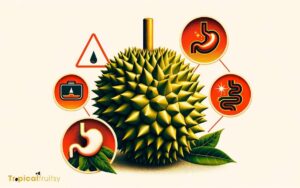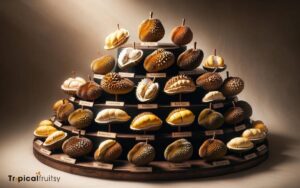What Is a Durian Tree? Discovering the Giant!
The Durian tree, scientifically known as Durio, is renowned for yielding the exotic durian fruit, dubbed the ‘king of fruits’. It is a staple in Southeast Asia’s tropical landscapes, flourishing in areas with a warm and moist climate.
Capable of reaching towering heights of up to 50 meters, the Durian tree is characterized by its elongated leaves and blooms that attract specific bat and bird pollinators.
The fruit itself is infamous for its spiky exterior and contentious smell but is highly valued for its creamy texture and complex taste.
Beyond its culinary acclaim, the durian is a powerhouse of nutrients, offering a significant energy boost with its content of carbohydrates, fats, and essential vitamins.
The Durian tree is indigenous to Southeast Asia and requires a tropical environment to prosper. The tree’s height can soar to 50 meters, and it is adorned with long, narrow leaves.
The flowers of the Durian tree play a crucial role in the reproductive process, relying on particular bats and birds for pollination.
The durian fruit, with its thorny covering, is the tree’s most notable feature.
Despite its strong odor, which some find unpleasant, the fruit is celebrated for its custard-like pulp and is a significant aspect of both the culinary and nutritional landscape in Southeast Asia, influencing local customs and contributing to the economic framework.
The Durian tree’s impact extends beyond its sensory qualities, embodying a cultural icon and an economic pillar in Southeast Asia.
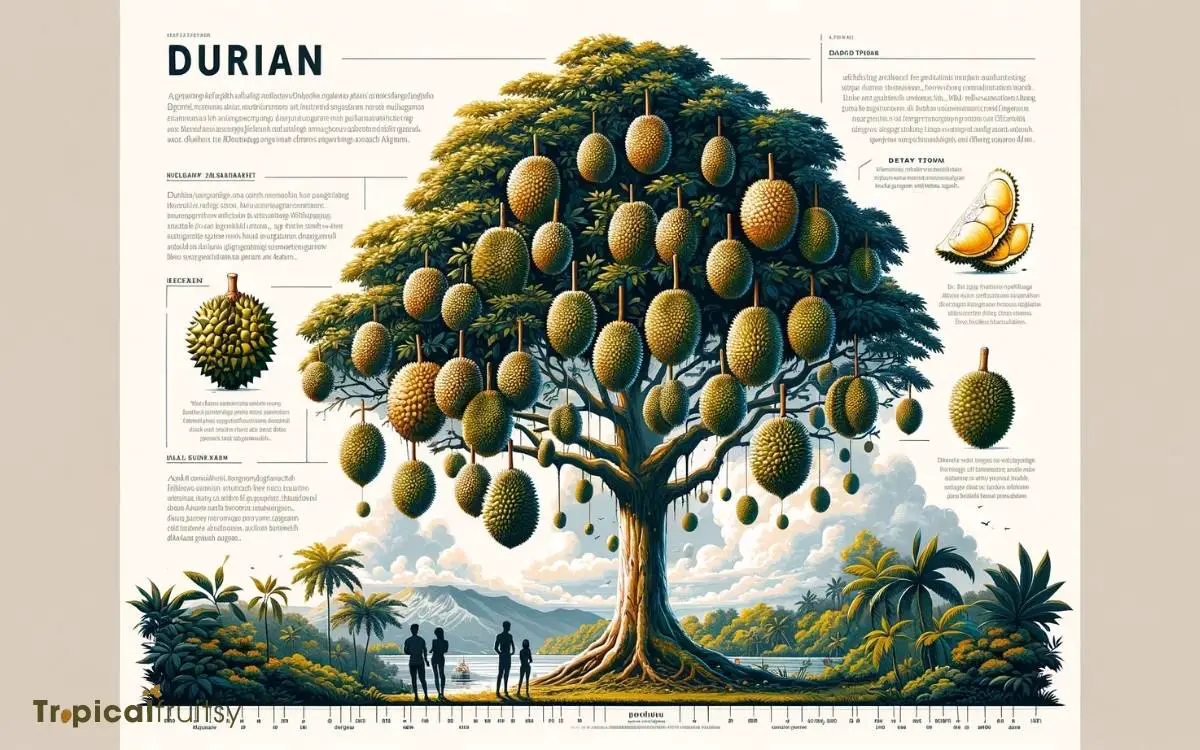
Key Takeaway
Durian Tree Profile: Understanding the King of Fruits’ Origin
| Characteristics | Details |
|---|---|
| Scientific Name | Durio |
| Native Region | Southeast Asia |
| Preferred Climate | Tropical |
| Maximum Height | Up to 50 meters |
| Leaf Shape | Oblong to lanceolate |
| Pollination | By bats and birds |
| Fruit Description | Large size, thorny husk, creamy flesh, strong aroma |
| Nutritional Content | Rich in carbohydrates, fats, vitamins |
| Cultural Significance | Integral to traditions and economies of local regions |
Durian Tree Profile
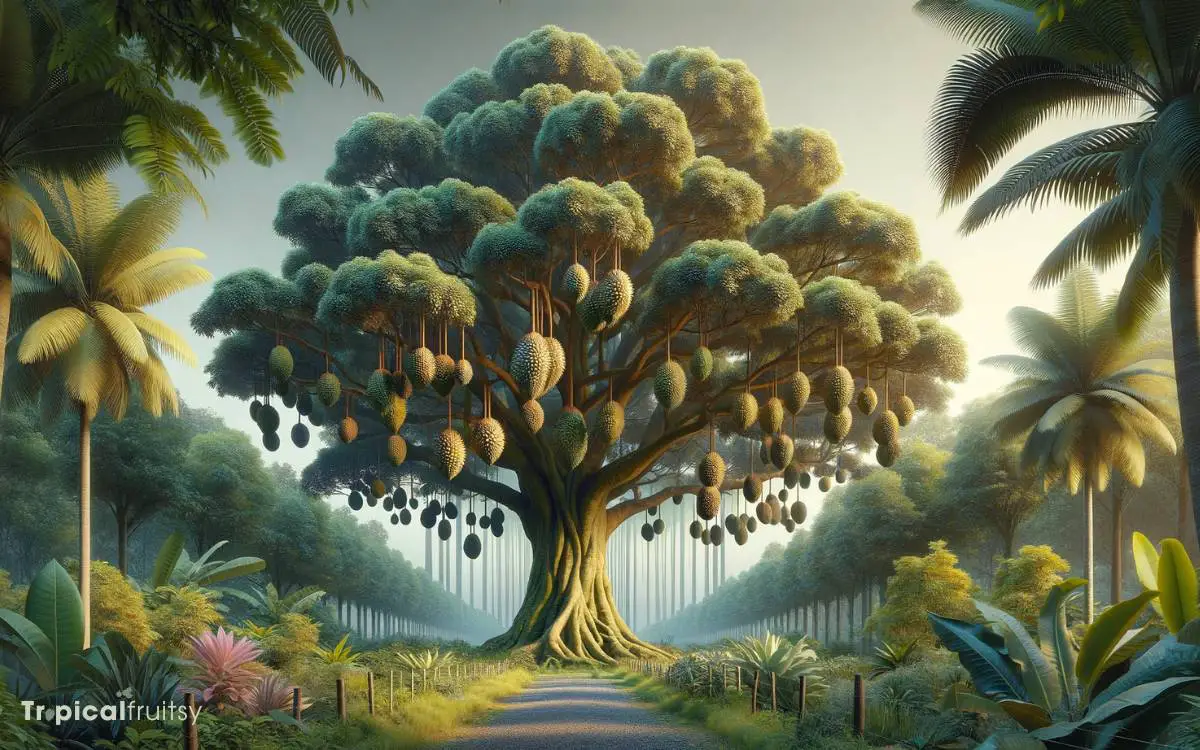
The durian tree, scientifically known as Durio zibethinus, is a tropical species belonging to the Malvaceae family, renowned for its distinctive, large, and spiky fruit.
Native to Southeast Asia, it thrives in wet, equatorial climates, requiring ample rainfall and rich, well-drained soils to prosper.
The durian tree exhibits a formidable stature, reaching up to 50 meters in height in wild conditions, though cultivated varieties are generally shorter. Its leaves are evergreen, elliptic to oblong, and exhibit a glossy, deep green sheen.
The durian’s flowering phase involves the production of large, white blossoms, which are pollinated by bats and certain insects. Notably, the tree’s age, soil fertility, and environmental factors critically influence its fruiting cycle.
In the upcoming section, we will delve into the durian’s unique sensory characteristics, which have provoked strong reactions and widespread curiosity.
Unique Sensory Characteristics
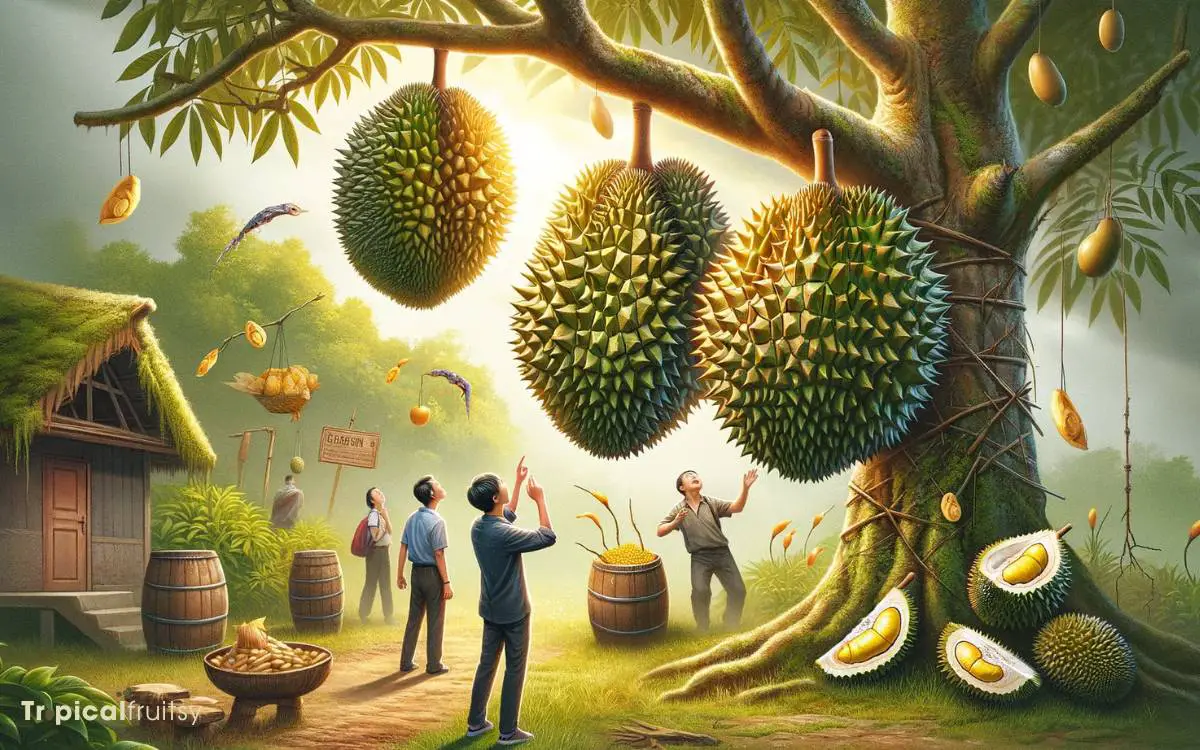
Amidst its towering presence, the durian fruit is most notable for its pungent aroma and complex flavor profile, which elicit polarized responses from individuals upon first encounter.
Scientific analysis reveals that the odoriferous qualities of durian emanate from volatile sulfur compounds, among others, that are generated during the ripening process.
These compounds, including ethanethiol and methionine derivatives, are responsible for the fruit’s distinctive smell, often compared to a blend of rotten onions, turpentine, and raw sewage.
The flavor of durian, meanwhile, is an intricate tapestry of sweet and savory notes, with hints of almond-like nuttiness, which is attributed to a combination of esters and ketones.
This multifaceted flavor, together with the creamy texture of the pulp, underpins the fruit’s reputation as the ‘king of fruits’ in Southeast Asia.
Cultivation and Harvesting
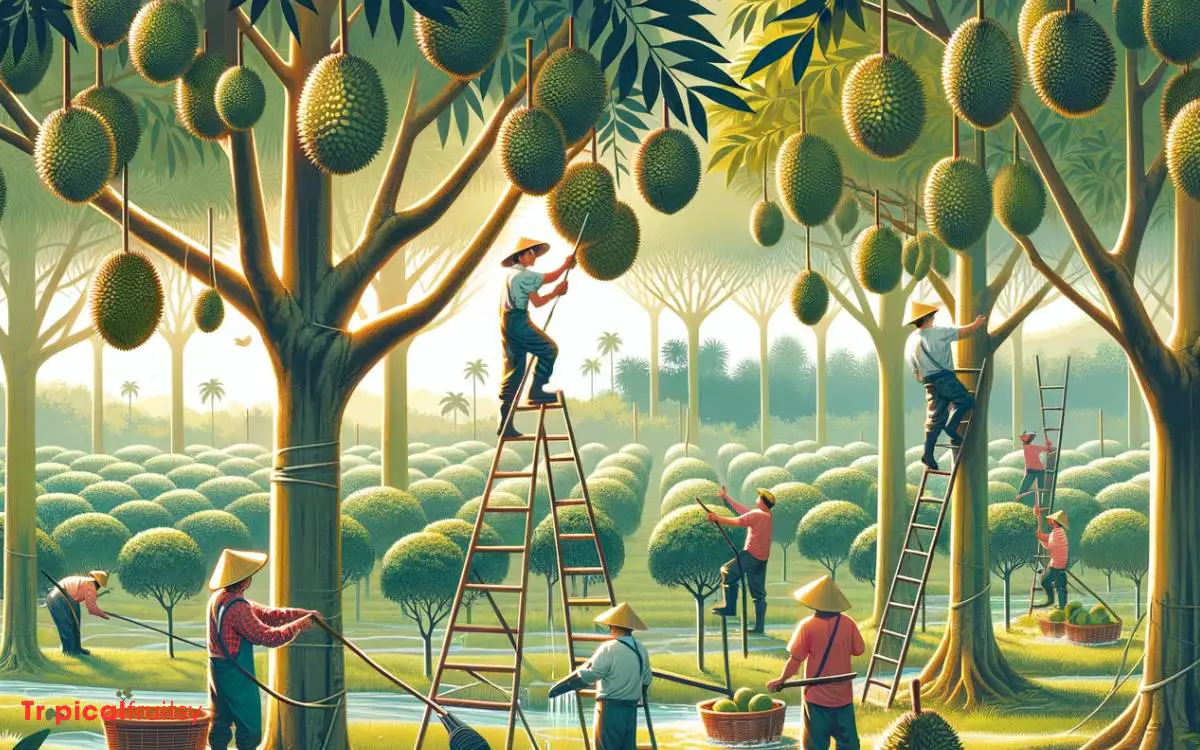
Durian trees, botanically known as Durio species, require specific tropical climates and soil conditions to thrive and produce the notorious fruits discussed earlier.
Cultivation of these majestic trees must adhere to precise horticultural practices, ensuring the successful development of their pungent bounty.
Ideal conditions include:
- High humidity levels, typically above 75%, to facilitate vital physiological processes.
- Well-drained, fertile loamy soils with a pH range of 6 to 7, ensuring nutrient availability.
- Temperatures ranging between 24°C to 30°C, which are critical for metabolic and growth rates.
- Adequate rainfall, approximately 1500 to 3000 mm annually, yet with a dry season to induce flowering.
Harvesting durians demands careful timing; fruits must be allowed to naturally fall, indicating peak ripeness, to harness their full, potent flavor profile.
Nutritional and Culinary Aspects
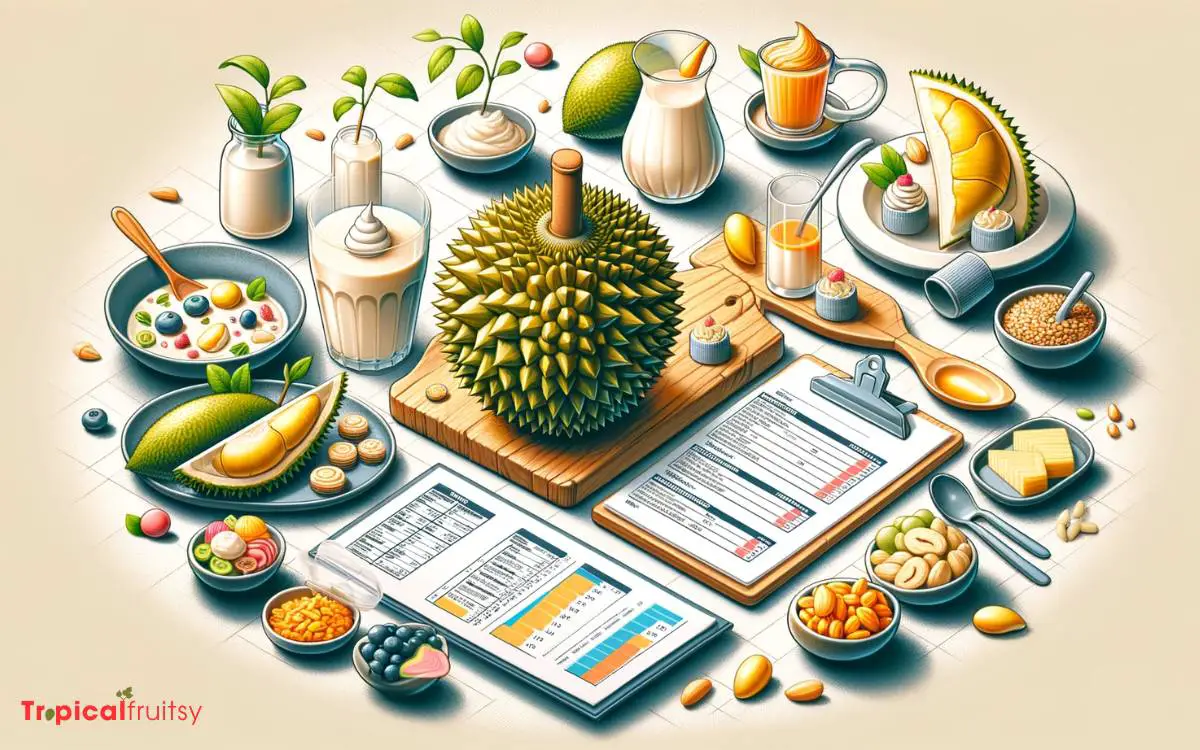
Rich in nutrients, durian fruit offers a unique combination of vitamins, minerals, and dietary fiber, making it a notable component in various Southeast Asian culinary traditions.
The fruit is especially high in vitamin C, which plays a vital role in immune function and skin health, and B-vitamins, including thiamin, riboflavin, and niacin which are essential for energy metabolism.
It also contains high levels of dietary fiber, beneficial for gastrointestinal health, and a rich array of minerals such as potassium, iron, and magnesium.
The high caloric content, mainly from carbohydrates and fats, provides a quick energy source.
Analytically, durian’s macronutrient profile supports its use as both a substantial dietary component and a culinary ingredient, despite its notorious odor, which has elicited polarizing reactions.
Cultural Significance and Uses
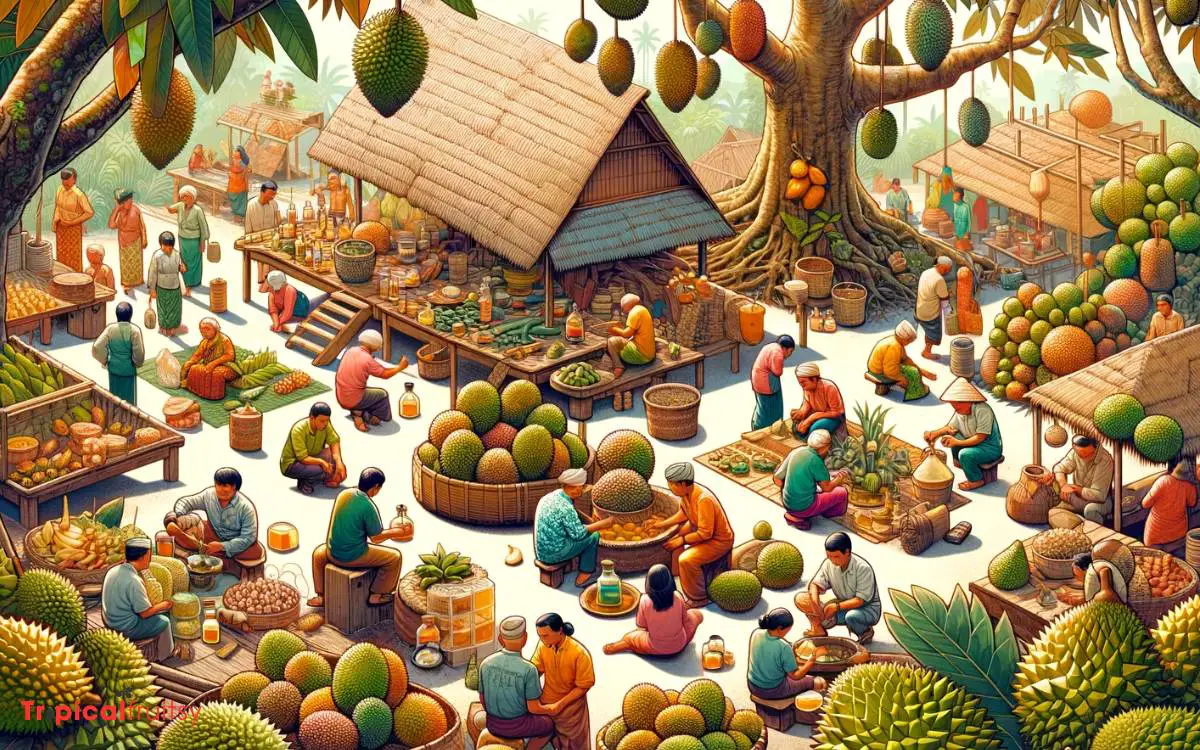
The cultural importance of the durian tree extends beyond its nutritional value, playing a pivotal role in social and culinary practices across Southeast Asia.
Within this region, the durian is often revered as the ‘King of Fruits,’ and its influence permeates various cultural facets:
- Festivals: Durian festivals celebrate the peak season, fostering communal bonding and economic stimulus.
- Folklore: Myths often surround the durian, attributing it with mythical qualities and weaving it into local folklore.
- Gastronomy: It is a prized ingredient in traditional recipes, symbolizing wealth and gastronomic indulgence.
- Agriculture: As a keystone species, durian trees influence ecological balance, shaping both natural landscapes and agricultural practices.
Understanding the durian tree’s cultural significance entails recognizing its multifaceted role in shaping traditions, economies, and ecosystems.
Conclusion
The durian tree stands as a botanical marvel, its formidable height casting a shadow over the rich tapestry of tropical agriculture.
The fruit, encased in a spiky armor, harbors a controversial bounty that splits sensory opinion.
Cultivation necessitates patience and skill, culminating in a harvest of nutritional abundance.
Integral to certain cultures, the durian’s presence weaves through culinary tradition and social fabric, encapsulating a complex relationship between nature and human indulgence.

